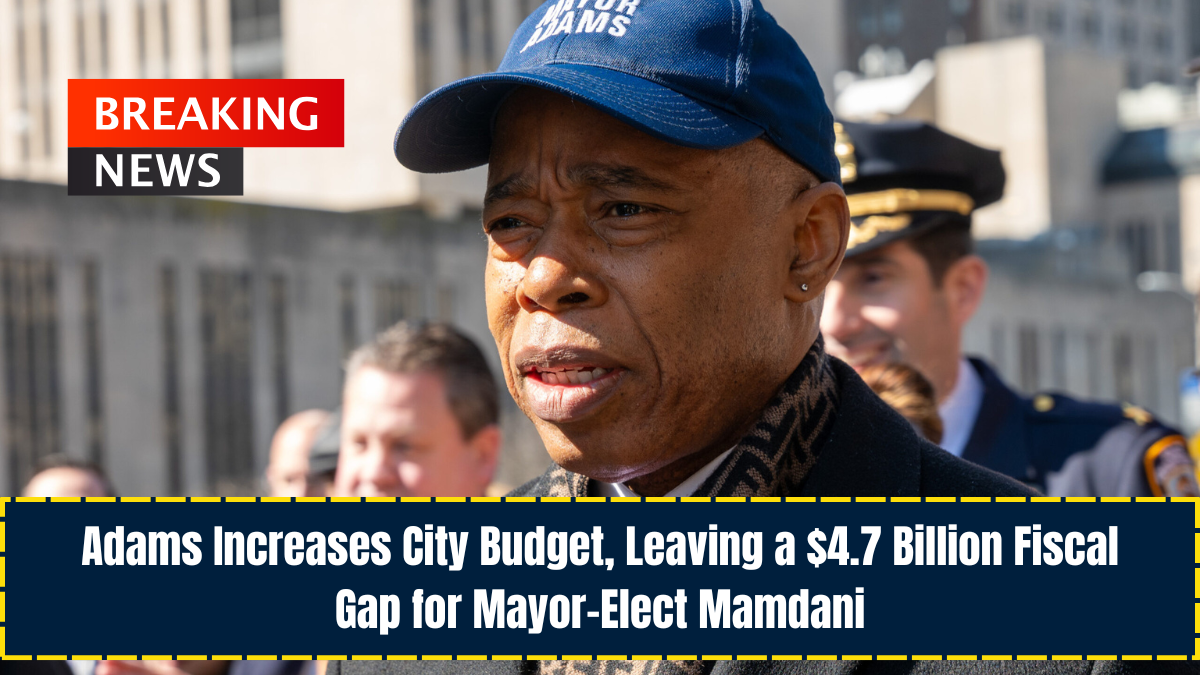Outgoing Mayor Eric Adams has expanded New York City’s spending plan, creating significant challenges for Mayor-elect Zohran Mamdani, who will take office next year.
With added expenditures and no outlined strategy to counter looming federal funding reductions, the city faces substantial financial uncertainty ahead.
Budget Boost Adds $2 Billion — and a Massive Deficit
Although currently abroad in Israel, Mayor Adams unveiled a major update to the city’s November budget modification, raising total spending for the 2025 fiscal year to $118 billion—about $2 billion more than previously planned.
This increase leaves a projected $4.7 billion deficit that must be addressed before the 2027 budget is finalized next summer.
In an unusual move, the administration released the budget update solely through a press release, skipping the traditional press conference and detailed briefings.
Key Highlights of the November Financial Update
The November modification outlines the city’s current financial status and forecasts for the next three years. Mamdani must deliver his first official budget proposal by February 1, just one month after assuming office.
New Spending Priorities
Adams’ revised plan includes:
- Funding to begin hiring 5,000 additional NYPD officers
- Expanded rental assistance funding
- An increase of 3,000 slots in an elderly caregiver program
These allocations clash with Mamdani’s stated goal of maintaining the police force at its current size of 34,000 officers.
Criticism from City Council Leaders
Outgoing Council Speaker Adrienne Adams and Finance Chair Justin Brannan sharply criticized the new commitments, calling them fiscally reckless. They noted that the NYPD already struggles to maintain its current staffing levels due to recruitment and retention issues.
Revenue Adjustments
For the first time in four years, Adams’ administration increased projected revenues—adding a modest $400 million for 2027.
Adams Claims Stability, but Budget Watchdogs Disagree
Adams framed the update as evidence of “strong fiscal management,” arguing the city is positioned well for the future.
However, the Citizens Budget Commission (CBC) argues the administration is underestimating costs by $4 billion, pointing to:
- $1 billion needed for city-funded housing vouchers
- $600 million in shelter costs
- Historically underestimated police overtime
CBC President Andrew Rein warned that Mamdani will likely need to close a $5 billion to $8 billion gap, prepare for federal cuts, and still fund his own policy agenda.
Short-Term Relief, Long-Term Challenges
Budget experts say the 2026 deficit may ultimately shrink thanks to:
- Strong Wall Street profits, boosting tax revenue
- A new city worker health plan expected to save nearly $1 billion annually
- Potential debt refinancing to reduce interest payments
But analysts stress that these improvements will be temporary.
Federal Aid Cuts Could Deepen the Crisis
New York City currently relies on more than $7 billion a year in federal support, much of which is expected to decline during Mamdani’s term—even without the possibility of additional cuts threatened by President Trump.
Statewide, the Fiscal Policy Institute predicts a loss of $8 billion in annual federal aid for programs such as Medicaid and SNAP, increasing pressure on New York State to shift more costs to cities, including NYC.
Major Costs Ahead for Mamdani’s Agenda
Once in office, Mamdani must figure out how to finance his ambitious proposals, which include:
- Universal free child care (estimated up to $6 billion a year)
- Free buses citywide (approximately $700 million annually)
- Building 200,000 affordable housing units using union labor
- Creating city-owned grocery stores
- A long-term $100 billion affordable housing investment, with $70 billion borrowed
Mamdani’s transition team has not yet commented on the revised budget.
Conclusion
Mayor Adams’ final budget update significantly expands spending while leaving a multibillion-dollar deficit and no plan for upcoming federal aid losses.
As Mayor-elect Mamdani prepares to take office, he faces one of the toughest fiscal landscapes in years — balancing inherited shortfalls, declining federal support, and the funding needs for his expansive policy agenda.
FAQs
1. How large is the deficit that Mayor-elect Mamdani must address?
The updated financial plan includes a projected $4.7 billion deficit, which analysts say could ultimately range from $5 billion to $8 billion.
2. Why is federal aid expected to drop?
New York could lose billions in Medicaid and SNAP funding as federal support is reduced nationwide. The state may shift these costs onto cities.
3. What major programs will Mamdani need to fund?
His proposals include free buses, universal child care, city-run grocery stores, and a $100 billion housing plan, all requiring substantial long-term investment.




